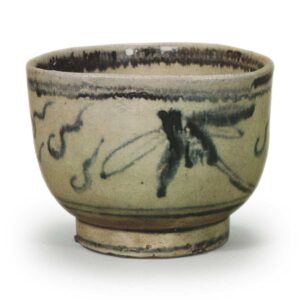
Anan-yaki is the name of pottery imported from Annam (Vietnam). There was considerable traffic between Japan and Annam from the late Muromachi period (1333-1573) to the early Edo period (1603-1868), and the yatong kinchamba pottery transported by these ships was probably produced in the Tokyo, Annam, and Ujusuku areas. The “Manpo-Zensho” says, “Annam is a place where the color of dyeing is rich and the quality of the goods is poor, and the items are not rare, but are treasured for their antiquity. There are two types of Annam ware that have been cherished by tea masters since long ago: plain Annam ware and gozu Annam ware, both of which are rich in wabi-ish taste. All Annam ware is ring-fired, and the clay is white with a slightly yellowish hue with a bluish tinge to the ground glaze. Those without patterns are called “plain annam” and are rarely produced in the present day. Ordinary wares are called “Gosu Annan” because they are painted with gosu, which is not recognizable as a letter or pattern, and the glaze is not cracked on the top pieces. The Annam ware is divided into Annam Oribe, Annam-e Koryo, Annam-e Kote, and Annam-e Kote. Although the Annam ware of modern potters is a hardened version of kojie ware, it was produced in Iga, Shigaraki, and Akashi in Harima Province (Hyogo Prefecture). They were produced in Iga, Shigaraki, and Akashi, Harima Province (Hyogo Prefecture). They were made by applying an opaque blue or green ground glaze over rough pottery and then painting a heaping-up calendar-like pattern on it in white mud. This technique was probably adapted from the decorative techniques used in Koji ware. There is a detailed description under the article on Annam in “The Study of Pottery,” and an article by Hara Bunjiro in “On Annam Ware” in “Saijokai Lecture Record.



